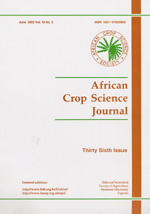
|
African Crop Science Journal
African Crop Science Society
ISSN: 1021-9730
EISSN: 1021-9730
Vol. 10, No. 3, 2002, pp. 203-209
|
 Bioline Code: cs02020
Bioline Code: cs02020
Full paper language: English
Document type: Research Article
Document available free of charge
|
|
|
African Crop Science Journal, Vol. 10, No. 3, 2002, pp. 203-209
| fr |
Tukamuhabwa, P.; Dashiell, K.E.; Rubaihayo, P. & Nabasirye, M.
Résumé
L'éclatement de gousses de soja et la contrainte
majeure à la production causant des pertes dans les tropiques et les sub-tropiques.
Concernant l'éclatement de gousses, les variétés de soja peuvent
être classées comme tolérantes, intermédiares ou susceptibles.
Six lignées de soja, Nam2, TGx 1448-2E, Duiker, Nam1, TGm 737 P et Kabanyolo
1 étaient plantées en trois endroits et pour trois saisons (1997-1998)
pour déterminer les pertes en graines dans les champs causées par l'éclatement
de gousses et les effets de l'intéraction GxE sur l'éclatement.
Se basant sur le nombre de gousses éclatées et non-éclatées,
la quantité de soja perdue dans les champs par éclatement était
déterminée. Les pertes de rendements pour les variétés susceptibles
et intermédiaires rangées entre 57 et 175 kg ha-1 et 0 et
186 kg ha-1, respectivement ; selon le génotype, la location,
la saison et la date de la moisson. Les variétés résistantes n'ont
pas éclaté même quand elles étaient récoltées avec
21 jours de retard. La perte en champs due à l'éclatement de gousses
était estimée et ces estimations sont considérées très
utiles dans les programmes de transformations quand les variétés résistantes
à l'éclatement sont sélectionnées.
Mots Clés
Intéraction génotype et environnement, Glycine max  , variétés susceptibles , variétés susceptibles
|
| |
| en |
Determination Of Field Yield Loss And Effect Of Environment On Pod Shattering In Soybean
Tukamuhabwa, P.; Dashiell, K.E.; Rubaihayo, P. & Nabasirye, M.
Abstract
Pod shattering in soybean is a major production constraint causing high field
yield losses in the tropic and sub tropics. With regard to pod shattering, soybean
varieties can be categorised as tolerant, intermediate or susceptible. Six soybean
lines, Nam 2, TGx 1448-2E, Duiker, Nam 1, TGm 737P and Kabanyolo 1 were grown
at three locations for three seasons (1997 - 1998) to determine field seed yield
losses due to pod shattering and the effect of G X E interactions on shattering.
Based on the number of shattered and unshattered pods, the amount of soybean seed
yield lost in the field due to pod shattering was determined. Yield losses in
susceptible and intermediate susceptible varieties ranged from 57 - 175 kg ha-1
and 0 - 186 kg ha-1, respectively depending on genotype, location,
season and harvesting date. The resistant varieties did not shatter even when
harvested after a delayed harvesting period of 21 days. Field yield loss due to
pod shattering was estimated and such estimates are considered useful for breeding
programmes when selecting varieties for resistance to shattering.
Keywords
Genotype x environment interactions, Glycine max  , susceptible varieties , susceptible varieties
|
| |
© Copyright 2002 - African Crop Science Society
|
|

 , susceptible varieties"/>
, susceptible varieties"/>